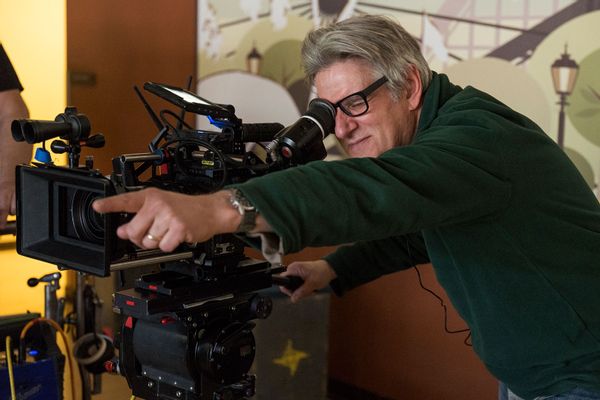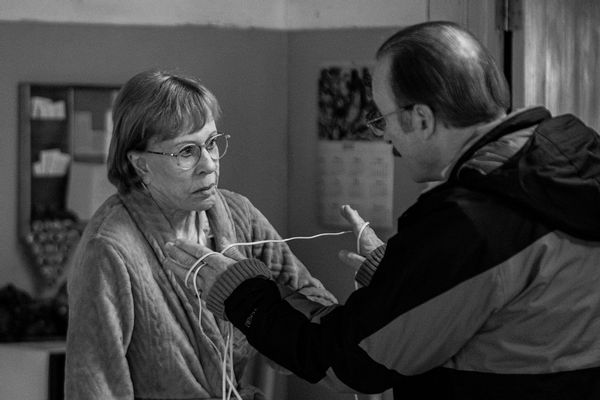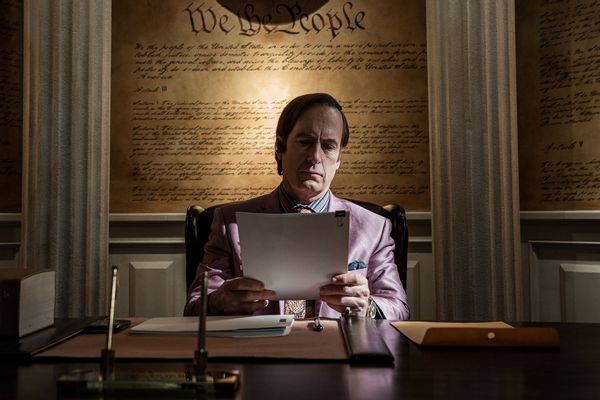
It would probably warm "Better Call Saul" showrunner Peter Gould's heart to think of the show as a keepsake, something we'll return to time and again to enjoy its consistent excellence despite knowing how many of its tragic protagonist's decisions wreck us and, ultimately, will destroy him.
Vince Gilligan, who co-created the "Breaking Bad" prequel with Gould, understands the addictiveness of that pain. "The more you love the characters – and we're not immune to this, we're kinda the first fans of the show – the more you grow to like these characters," he said at a recent Television Critics Association press conference, adding, "And when you watch Jimmy/Saul/Gene devolve as a character, I picture him, like, snipping pieces of his own soul off with a pair of tin snips. . . . It's a tragedy, and it gets more and more uncomfortable and sad."
Nevertheless, the show provides many a lot of reasons to refrain from looking away, starting with Bob Odenkirk's and Rhea Seehorn's outstanding evolutions of Jimmy McGill (aka Saul Goodman, aka Gene Takavic, aka Viktor Saint Claire) and Kim Wexler, respectively.
Jimmy's recklessness in recent episodes prove that regardless of whether he's evaded the law, he can't outrun his impulse to destroy himself. But the delight in "Better Call Saul" has always been in the details.
The visual language of "Better Call Saul" does its own share of heavy lifting, fully ensconcing us in the black and white wilderness of his post-Heisenberg life in Omaha, Nebraska as the story careens towards its conclusion. That, along with the assortment of objects that define who Odenkirk's con man was and is, saturate the most seemingly mundane corners in the series with meaning and magnitude in ways no other TV show can match.
Before the series finale, Salon chatted with Gould about the impending conclusion in addition to the cinematic artistry and conscientious employment of props and objects that made watching the tragedy of Jimmy McGill unfold over six seasons such an addictive, timeless pleasure.
Let me start by asking about the finale's title: "Saul Gone."
"S'all gone!"
How long did you have that in mind?
You know, my wife and I have a theory about babies: that you don't really know the name of the baby until you meet the baby. And oftentimes, with TV episodes, you have to watch the episode to really understand what the episode really is, as opposed to what you thought it was going to be. And in this case, it came when I watched it. I had a couple other pitches – I can't think of what they were right at the moment – but it seemed like the right thing once we got there.
And of course, it's playing on Jimmy McGill's Saul Goodman. Just . . . what a ridiculous name. Saul Goodman. "It's all good, man." So: "Saul Gone."

Well, you've been building to that from the beginning of this entire fraud scheme . . . we'll see how it happens in the finale. What I want to talk about is the cinematic language of this final season.
You've incorporated a lot of small classic cinema homages throughout the season, and certainly more since the season shifted over to more to Gene's perspective and went more heavily into black and white film. . . . Gene Takavic has existed in black and white since the beginning of "Better Call Saul." Now that we're enmeshed in his timeline, how did that affect the filming of the final episodes of the series?
Filming in black and white is its own thing. It's not just the absence of color. And that's one of the things that we discovered as we shot the previous black and white sequences. Knowing that we were going to spend a lot of time in Gene's world and in black and white, we did some thinking about what that meant.
"The great thing about television is that you can pull out every technique that's available."
I actually did a little slideshow for all the directors and the [directors of photography] for these last few episodes. I went back over some of the black and white movies I admire . . . I picked, you know, "Rumble Fish" . . . and "Sweet Smell of Success" was one that we looked at quite a bit. We'd take images and say, "Well, what what's interesting about this? . . . What can we learn from the way black and white has been used in the past?"
We learned a lot of things. One is the importance of texture. Because if you don't have color to distinguish surfaces, you need texture. . . . And it's a tricky thing. Another of the things you always have to deal with in a two-dimensional medium like film is separation. How do you know, if you have two things that are dark? How can you separate them visually? It creates a whole different level of composition and in some ways, it's really challenging. But they ran with it and did a wonderful job.
Those sequences make me think of the film noir era and the way directors used black and white to augment the emotional tone of those stories. That suits what you are doing with, and did, with "Better Call Saul" by constructing the psychological explanation of how this character came to be. Can you talk about how using black and white adds to the script? Or maybe I mean to say subtracts because, correct me if I'm wrong, but but seems like there's a lot less dialogue in Gene's segments.
There is less dialogue, especially in the beginning, because all the time that Gene's been in Nebraska, he's been terrified of being found out. He does not want to get caught. At least, that's what he thinks. So there is less dialogue, and especially at the beginning.
And then also we use music differently. One thing that we didn't do very often earlier was to underscore dialogue scenes. And Dave Porter, our composer, started to suggest underscoring some dialogue scenes, right from the first black and white episode.
If you see that that first scene where Gene meets Marion (Carol Burnett), there's a little bit of an underscore, which is different than the regular scoring. Dave adds a little theme to it that sounds a little bit like "Peter and the Wolf." It's this little devilish theme that comes in when Gene is worming his way into Marion's life. So yeah . . . we're all big movie buffs. And the great thing about television now is that you can pull out every technique that's available. I think we're determined to try to use every part of the medium that we can to tell the story.

That brings us to the visual symbols that people have always kept an eye on in "Breaking Bad" and "Better Call Saul." How much is that coordinated in the script, and how much is left up to the director's spontaneity?
Not all of those things come out of the writers' room, but I'd say more than half does. Like you know, the candle in Tom [Schnauz's] episode, "Plan and Execution," that was very specifically discussed in the writers' room. We were thinking, how do we give Lalo an entrance here?
I love the question, because we're fascinated by the physical world and by what happens if you pick a little detail out – like the way a character ties his tie or a slide rule embedded in Lucite – all of these things just add to the dimensionality of the world.
Probably one of the biggest ones on the show is the pinkie ring. You know, the very first time Bob was on "Breaking Bad," we put a pinkie ring on him. And then we started thinking, where's the pinkie ring come from? What does it mean? And as the show has evolved, we found out that it was his friend Marco's ring. And for a long time, "Better Call Saul" he has to wear it with a little bit of red thread around the ring to size it. But by the time we get to Omaha, he's had this ring resized. We think about all these things.
So what do you think are the defining symbols, besides the ring, of Gene or whoever this man that Jimmy McGill is, as he's leaving us?
I like to think that we've given a lot of these characters important objects and symbols. Kim, certainly has the earring and necklace set that she's wore. And her ponytail turns out to be very, very important, to the point that when it's gone in the black and white sequences, it's kind of disturbing.
Peter, all of Kim's fashion choices in the black and white sequences are disturbing.
I couldn't agree more! Look, Rhea Seehorn made it work for her. That shows she's such a fantastic actor.
But boy, I don't know if I can tell you what's most important. Certainly, there's Saul's color palette, and all the symbols of Saul's office, you know: the Statue of Liberty, the Constitution wallpaper, all the references to Greek architecture.

I like to think that there are objects that tell the story. And there's a very important object produced a couple of times this season that becomes really important in the series finale. And it's exactly the kind of thing that we're talking about. It's never mentioned in dialogue, really, but it turns out to be a thread that ties a lot of pieces together. So yeah. you're definitely picking up what we're putting down, you're seeing things that we put there with great care. It's not so much that we're trying to hide things. We're trying to use the physical world to tell the emotional story.
"I think it's going to be devastating to me once it really sinks in," says Gould.
I mean, one example of that is the teaser for the entire season; we had a tour through Saul Goodman's house, right? At the very beginning where people were stripping it. Well, I wrote that script. And in the script I wrote that we should see as many objects as we can crammed into this sequence. And I sort of threw it open not just to the director, but to the whole crew in the prop department.
And, you know, what are the significant objects that we can put in here? The reason that's interesting to me is not just, "Oh, look at that. That's fun that we're revisiting that." But it helps you think about all the decisions, and all the things that happened that brought this character to this point
Maybe for some folks, it's just fun, which I think is fine. But for me, it gives me an emotional way to think about how all these decisions and all these moments added up. And what a terrible path this guy took at the end of that road. Those are things that we're thinking about for sure.
Yeah. Jimmy McGill is clearly a man who has defined himself by what he has, and not necessarily by who he is, although he is many different people at once. That comes across in the visuals.
And like a lot of us he's searching for who he is. I think that in some ways, that's the human condition.
What are what do you think that you're going to miss the most about this show? You've said that this will probably be the last series in the "Breaking Bad" universe. What are going to miss most about "Better Call Saul"?
You know, there's two sides of what I'm gonna miss. One thing I'm gonna miss is playing in this world, because it's this world that Vince started and we all got to contribute to it. It's a fantastic playground. But the other creative side is the personal side, which is, you know, I've been working with a lot of these people for 15 years straight, and working very hard, long hours. And everyone in the crew, the cast, the writers room are incredibly important to me personally. I can understand why there's a temptation for a show to just go on indefinitely, and certainly part of that is monetary.
But the other part of it is you have this urge to keep the band together. This is an amazingly talented, nice group of people. . . . And it's gonna be really tough, not working all together again. I'm gonna miss all of that. And I think it's going to be devastating to me once it really sinks in.
The series finale of "Better Call Saul" airs Monday, Aug. 15 at 9 p.m. on AMC.







